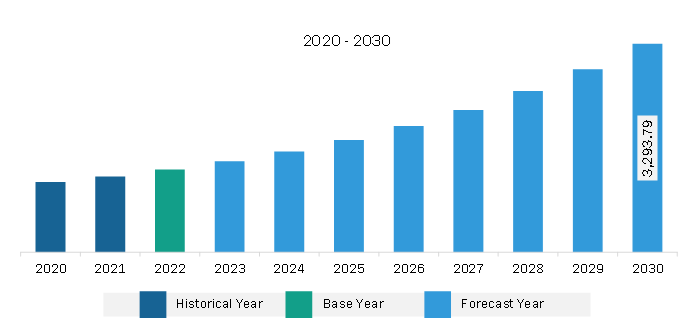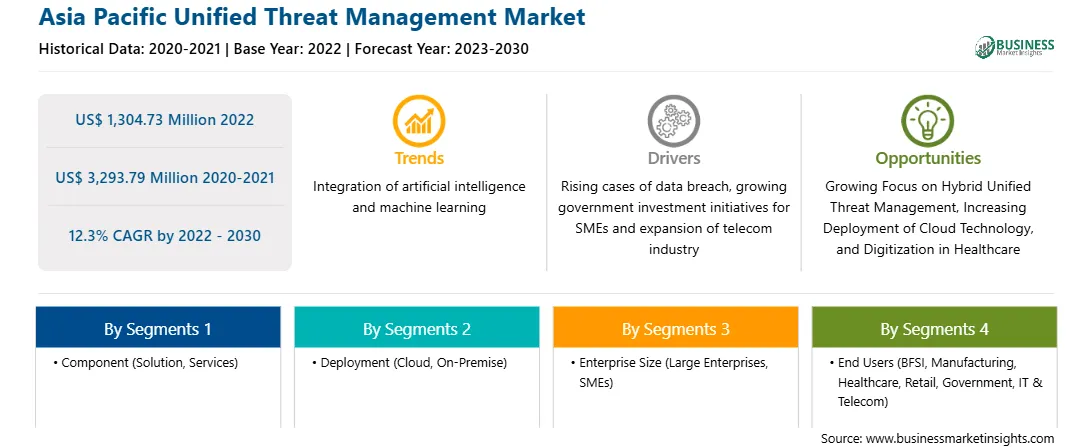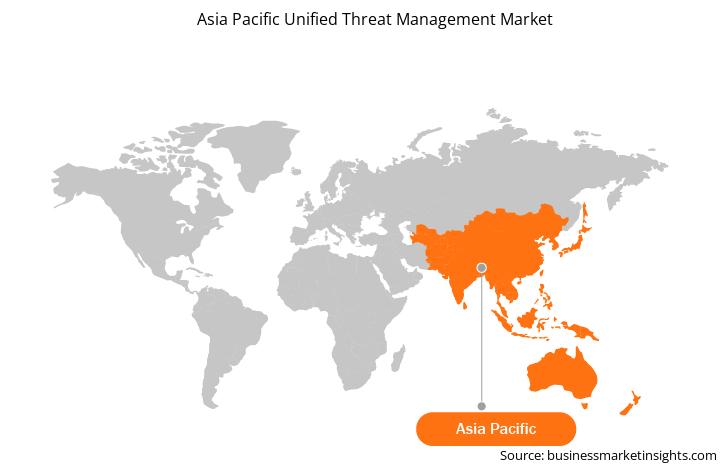Asia Pacific Unified Threat Management Market
No. of Pages: 102 | Report Code: BMIRE00030279 | Category: Technology, Media and Telecommunications
No. of Pages: 102 | Report Code: BMIRE00030279 | Category: Technology, Media and Telecommunications
The Asia Pacific unified threat management market was valued at US$ 1,304.73 million in 2022 and is expected to reach US$ 3,293.79 million by 2030; it is estimated to register at a CAGR of 12.3% from 2022 to 2030.
Healthcare institutions are undergoing a significant digital transformation involving a mounting reliance on technology to deliver patient care and critical services. The rising digitalization in the healthcare industry offers access to medical information and services from anytime, anywhere, and ensures timely and efficient patient care. Digitalization has resulted in the introduction of several tools and methods for enhancing healthcare services. These tools help to keeps the record of patients' information and health-related data accessible to doctors as well as patients. However, due to growing digitalization in healthcare systems, the industry has become prone to various kinds of cyberattacks and threats. For instance, according to Check Point Software Technologies Ltd's Check Point Research (CPR), healthcare institutions experienced 1,426 weekly attacks in 2022, an increase of over 60% compared to 2021. Thus, the rising threats of cyberattacks and digitalization in the healthcare industry can generate the demand for enhanced security solutions. A unified threat management solution can protect healthcare institutions from attacks such as distributed denial of service (DDoS), ransomware, phishing, and malware. Thus, digitalization in the healthcare system creates lucrative opportunities for the Asia Pacific unified threat management market growth.
The Asia Pacific unified threat management market is segmented into Australia, China, India, Japan, South Korea, and the Rest of Asia Pacific. According to the report of IBM in 2022, the impacts of cyberattacks were felt throughout nearly all industries of the global economy. The leading industries that were attacked include manufacturing (25%), finance & insurance (19%), and professional, business, and consumer (PBC) services (15%). APAC was the most targeted region, finding itself subject to 31% of attacks. The increasing number of cyberattacks in APAC is fueling the demand for unified threat management solutions. Also, according to the report of Positive Technologies, cyber espionage is a major threat to organizations and states in Asia. As many as 49% of successful attacks on organizations resulted in compromise of sensitive information. Governments and organizations invest heavily in research and technology, and stealing this kind of information can give competitors a technological advantage. This explains the increased activity by cyberespionage gangs. Additionally, according to NetScout Systems, Inc.’s DDoS threat intelligence report, the total number of DDoS attacks in Asia Pacific was 1.5 million, in 2023, which is 16% higher as compared to 2022. The maximum bandwidth of the attacks is 632 Gbps, and the maximum throughput is 316 Mpps. The increase in cyberattacks is propelling the adoption of unified threat management technologies in Asia Pacific.

Strategic insights for the Asia Pacific Unified Threat Management provides data-driven analysis of the industry landscape, including current trends, key players, and regional nuances. These insights offer actionable recommendations, enabling readers to differentiate themselves from competitors by identifying untapped segments or developing unique value propositions. Leveraging data analytics, these insights help industry players anticipate the market shifts, whether investors, manufacturers, or other stakeholders. A future-oriented perspective is essential, helping stakeholders anticipate market shifts and position themselves for long-term success in this dynamic region. Ultimately, effective strategic insights empower readers to make informed decisions that drive profitability and achieve their business objectives within the market.

| Report Attribute | Details |
|---|---|
| Market size in 2022 | US$ 1,304.73 Million |
| Market Size by 2030 | US$ 3,293.79 Million |
| Global CAGR (2022 - 2030) | 12.3% |
| Historical Data | 2020-2021 |
| Forecast period | 2023-2030 |
| Segments Covered |
By Component
|
| Regions and Countries Covered | Asia-Pacific
|
| Market leaders and key company profiles |
The geographic scope of the Asia Pacific Unified Threat Management refers to the specific areas in which a business operates and competes. Understanding local distinctions, such as diverse consumer preferences (e.g., demand for specific plug types or battery backup durations), varying economic conditions, and regulatory environments, is crucial for tailoring strategies to specific markets. Businesses can expand their reach by identifying underserved areas or adapting their offerings to meet local demands. A clear market focus allows for more effective resource allocation, targeted marketing campaigns, and better positioning against local competitors, ultimately driving growth in those targeted areas.

The Asia Pacific unified threat management market is segmented based on component, deployment, enterprise size, end users, and country.
Based on component, the Asia Pacific unified threat management market is bifurcated into solution and services. The solution segment held a larger share in 2022.
In terms of deployment, the Asia Pacific unified threat management market is bifurcated into cloud and on-premise. The cloud segment held a larger share in 2022.
By enterprise size, the Asia Pacific unified threat management market is bifurcated into large enterprises and SMEs. The large enterprises segment held a larger share in 2022.
In terms of end users, the Asia Pacific unified threat management market is segmented into BFSI, manufacturing, healthcare, retail, government, IT & Telecom, and others. The IT & Telecom segment held the largest share in 2022.
Based on country, the Asia Pacific unified threat management market is categorized into Australia, China, India, Japan, South Korea, and the Rest of Asia Pacific. China dominated the Asia Pacific unified threat management market in 2022.
Fortinet Inc, Sophos Ltd., Juniper Networks Inc, Cisco Systems Inc, Huawei Technologies Co Ltd, Barracuda Networks, Inc., WatchGuard Technologies Inc, and Check Point Software Technologies Ltd are some of the leading companies operating in the Asia Pacific unified threat management market.
1. Fortinet Inc
2. Sophos Ltd.
3. Cisco Systems Inc
4. Juniper Networks Inc
5. Huawei Technologies Co Ltd
6. Barracuda Networks, Inc.
7. WatchGuard Technologies Inc
8. Check Point Software Technologies Ltd
The Asia Pacific Unified Threat Management Market is valued at US$ 1,304.73 Million in 2022, it is projected to reach US$ 3,293.79 Million by 2030.
As per our report Asia Pacific Unified Threat Management Market, the market size is valued at US$ 1,304.73 Million in 2022, projecting it to reach US$ 3,293.79 Million by 2030. This translates to a CAGR of approximately 12.3% during the forecast period.
The Asia Pacific Unified Threat Management Market report typically cover these key segments-
The historic period, base year, and forecast period can vary slightly depending on the specific market research report. However, for the Asia Pacific Unified Threat Management Market report:
The Asia Pacific Unified Threat Management Market is populated by several key players, each contributing to its growth and innovation. Some of the major players include:
The Asia Pacific Unified Threat Management Market report is valuable for diverse stakeholders, including:
Essentially, anyone involved in or considering involvement in the Asia Pacific Unified Threat Management Market value chain can benefit from the information contained in a comprehensive market report.